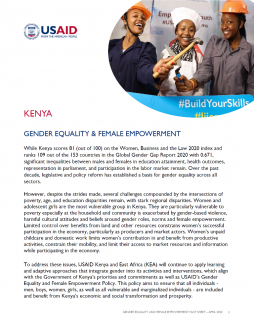While Kenya scores 81 (out of 100) on the Women, Business and the Law 2020 index and ranks 109 out of the 153 countries in the Global Gender Gap Report 2020 with 0.671, significant inequalities between males and females in education attainment, health outcomes, representation in parliament, and participation in the labor market remain. Over the past decade, legislative and policy reform has established a basis for gender equality across all sectors.
However, despite the strides made, several challenges compounded by the intersections of poverty, age, and education disparities remain, with stark regional disparities. Women and adolescent girls are the most vulnerable group in Kenya. They are particularly vulnerable to poverty especially at the household and community is exacerbated by gender-based violence, harmful cultural attitudes and beliefs around gender roles, norms and female empowerment. Limited control over benefits from land and other resources constrains women’s successful participation in the economy, particularly as producers and market actors. Women’s unpaid childcare and domestic work limits women’s contribution in and benefit from productive activities, constrain their mobility, and limit their access to market resources and information while participating in the economy.
To address these issues, USAID Kenya and East Africa (KEA) will continue to apply learning and adaptive approaches that integrate gender into its activities and interventions, which align with the Government of Kenya’s priorities and commitments as well as USAID’s Gender Equality and Female Empowerment Policy. This policy aims to ensure that all individuals - men, boys, women, girls, as well as all vulnerable and marginalized individuals - are included and benefit from Kenya’s economic and social transformation and prosperity.

